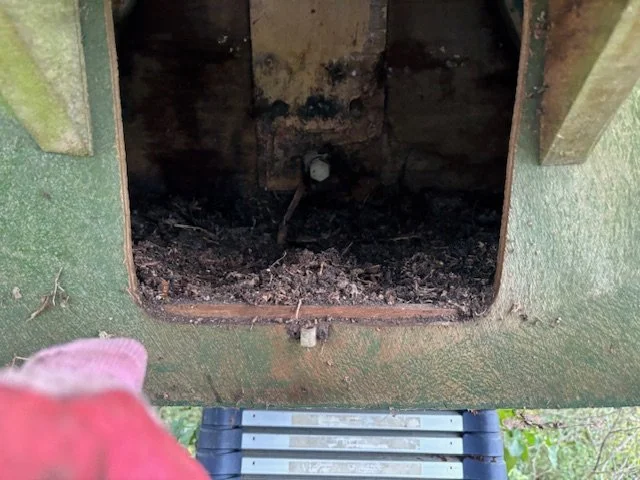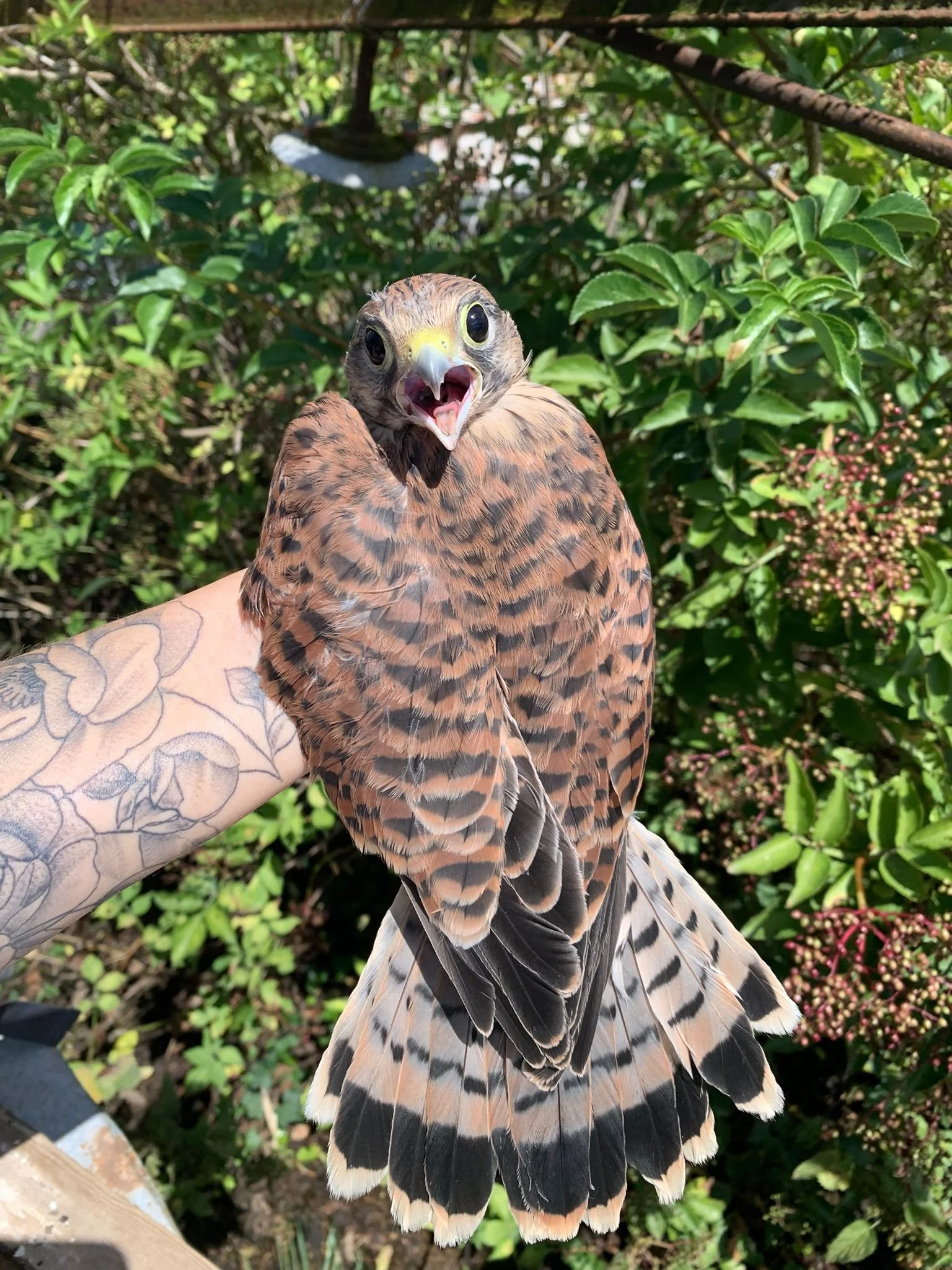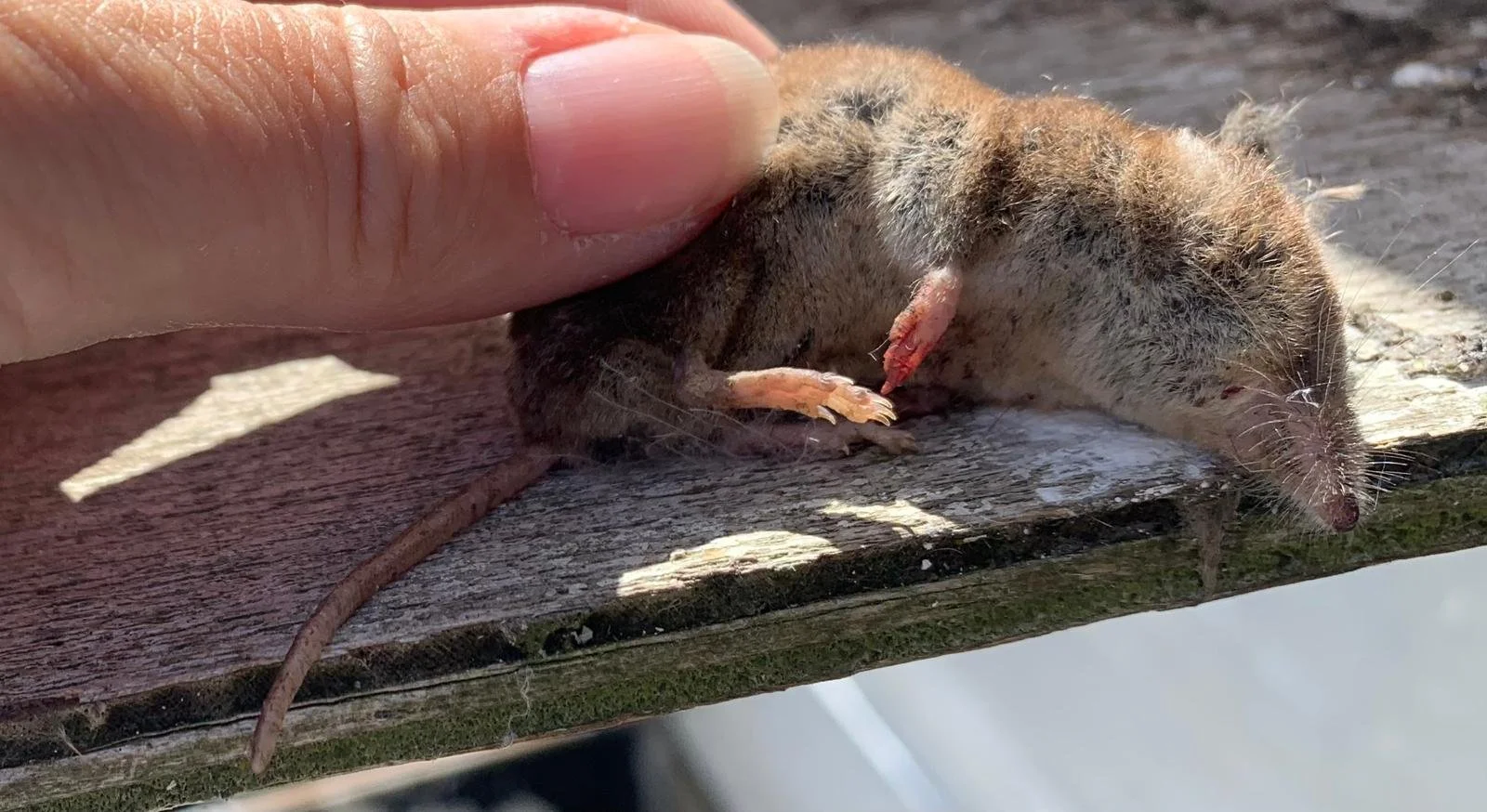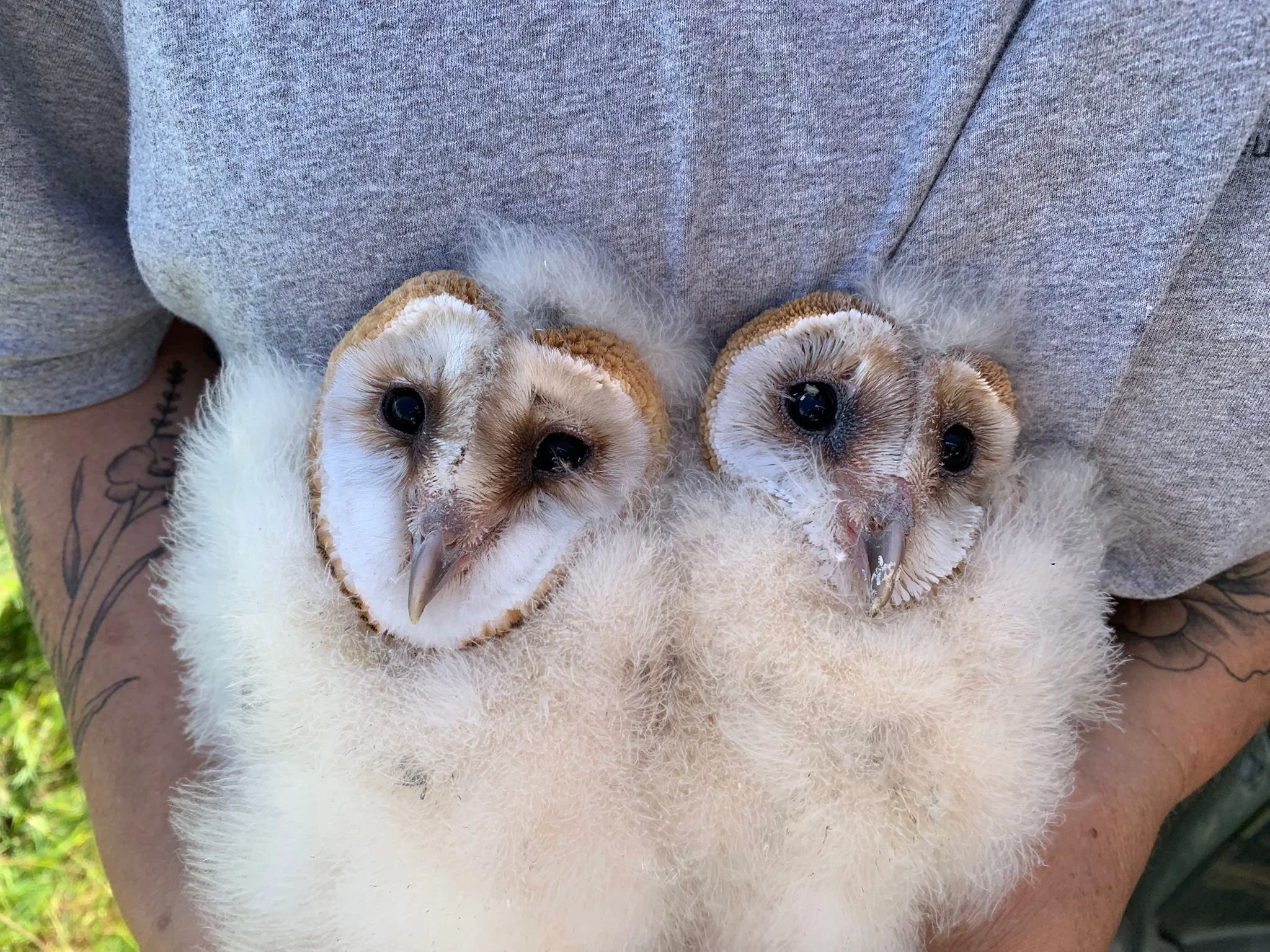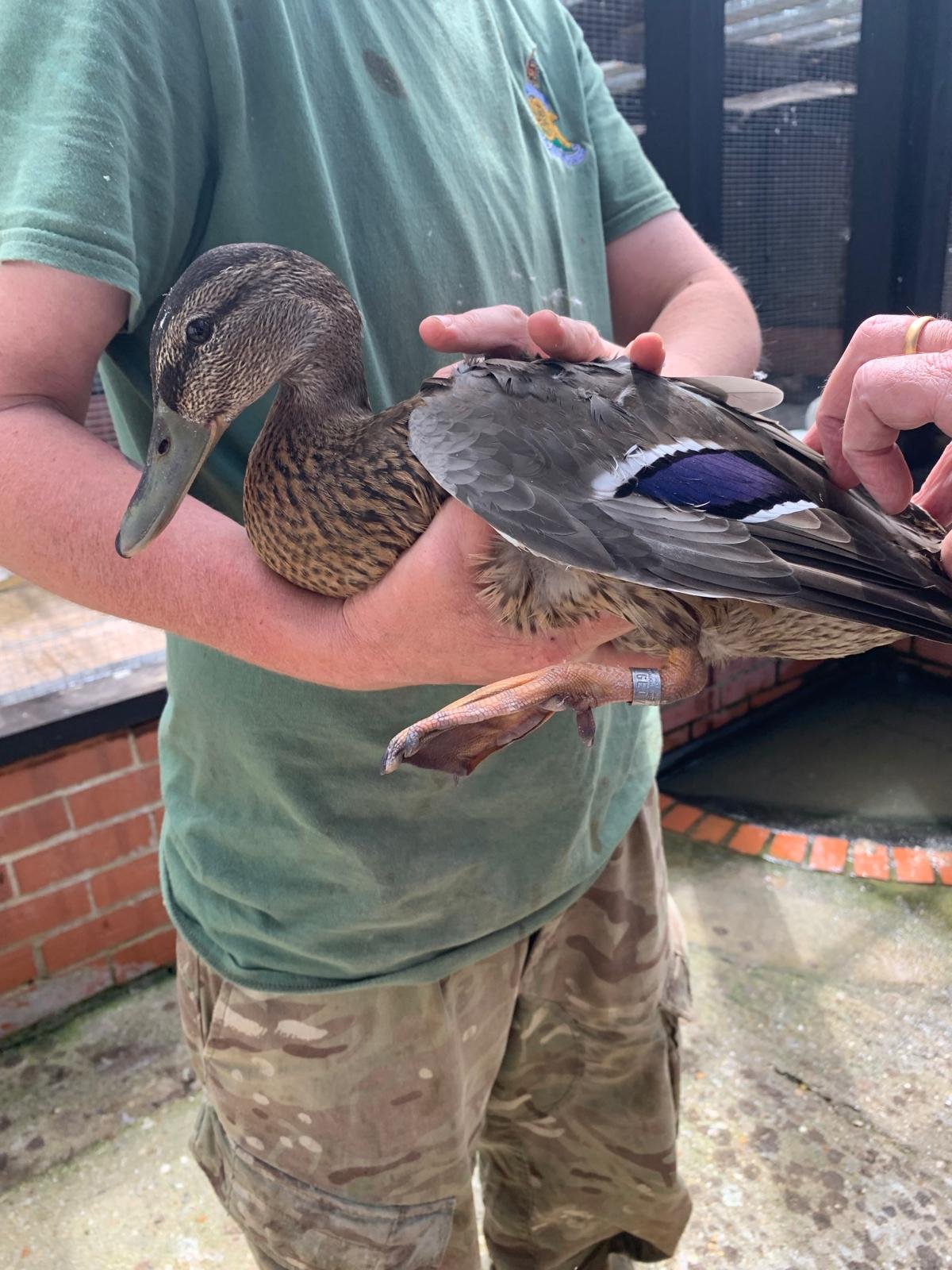Winter Clearing
I met with Sarah and Justin at noon at The Slindon Estate Yard before the winds picked up and the rain came in and we managed to get to five of their Barn Owl boxes to clear them out ready for 2026.
One of the boxes had been full to above the top of the entrance hatch (see 16th June 2025).
It had 2 stock dove eggs perched on top of the leaves when i peered inthe entrance hole in June so we had left them to hatch.
Today, I managed to clear it all out and left a lovely base of shredded pellets on the floor of the box. Hopefully there will be more room now to allow a pair of owls to move in.
Barn Owl box cleared out today
The box below on the edge of a woodland area had a fabulous nest above the entrance hole - maybe a wasp or a hornet?
Wasp or Hornet nest
Owlets …..at last
Dominic and I headed to Sidlesham to re visit an owl box which had kestrels breeding in it (see journal 17th June). We found 4 warm kestrel eggs on our last visit but had no idea when they were laid. I had planned to come back 10 days ago but due to unexpected circumstances I was unable to check the box until today.
We were lucky to find one remaining young kestrel with an item of prey in the box along side it. The other kestrels appear to have successfully fledged.
Young Kestrel - photo by Dominic.
Common Shrew
The next box was a barn owl box in a huge oak tree that we had been unable to check last time due to a large congregation of cows and 2 bulls under the box. Today, to our complete surprise an adult barn owl flew out of the box as we drove up. Dominic clambered up the ladder and even more of a surprise were 3 young owlets. I retrieved the youngsters and each was ringed and their wings measured and weight recorded.
Owlets- Estimated to be 30, 32 and 35 days old.
From here we made our way to Pagham to see how a barn owl box with 2 tiny barn owls chicks in it 4 weeks ago was coming on. When I opened the box up I was so surprised to see a stock dove (adult) in the left hand corner that I completely failed to hold onto it for ringing. In the back right corner were two healthy looking owlets ! The stock dove had made a cup nest in the front left corner but has not yet laid any eggs.
This pair of owlets were 37 and 42 days old.
Owlets photo taken by Dominic
I will keep you updated on these boxes, I will be returning in the autumn to check these owls have fledged and to clear out the boxes ready for next years breeding season.
Leconfield revisit…….
I met with Andrew and his daughter Milly to revisit 2 owl boxes at The Leconfield Estate. One box in a barn had 2 warm eggs in it on the last visit on the 11th June. We saw 2 adult barn owls fly out of the barn again as we approached it today and found evidence of primary moult on the floor of the barn as we entered. This did not bode well for owlets.
The box contained a crushed owl egg and a cold owl egg and at the far end of the box in a dip in the shredded pellets were what appeared to be warm Stock Dove eggs.
We retreated quickly to allow the adults to come back into their roost site.
Andrew was hopeful that another box might have owls in it, so we headed across the estate to a box cloe to where he had seen an unringed male barn owl reguarly in the past 2 weeks. This box had had a well developed Stock Dove in it on the last visit.
We put up the ladder and found that the previous stock dove chick had fledged and there were another 2 Stock Dove chicks in the nest. We ringed the two small chicks and as the chicks were returned to the nest we noticed some owl feathers towards the back of the nest. Unfortunately this was a dead nestling from the previous year wearing ring number GY84610.
Pair of stock dove chicks (IP)- photo by Milly Thompson
Sadly deceased Barn Owl (ring removed)
We headed back to Andrews house to discuss the potential of mist netting on the estate and in Andrew’s garden (over a cup of tea).
This really is the worst year I have experienced since starting Barn Owl ringing in 2010 with Barrie. The university of Sussex are looking into what might be causing this sudden drop off in breeding.
Details can be found here https://www.bbc.co.uk/news/articles/cx204gjx8xdo?at_format=link&at_ptr_name=facebook_page&at_link_id=15690730-62FA-11F0-AA0A-E61366C63AD3&at_medium=social&at_campaign_type=owned&at_campaign=Social_Flow&at_link_origin=BBC_Sussex&at_bbc_team=editorial&at_link_type=web_link&fbclid=IwY2xjawLmMRpleHRuA2FlbQIxMQABHua2jEsV__h8v2OFgLiOHjy7e0iEkylPNr0DDTCS1ZleiUdiN9F_MxUChrvm_aem_Ue0cdIgwOSlsetfvv_JmFg
National Rehabillitated Gull Project
Mike Bailey and I met again at Brent Lodge to metal and colour ring some soon to be released juvenile Herring Gulls (Larus argentatus). All the birds today have been brought in by members of the public and have been orphaned or fallen from their nests or their nests destroyed.
Herring Gulls are a species of conservation concern, listed as Red-listed due to significant population declines. Herring Gull populations have declined considerably, especially along the coast, with a more than 50% decrease noted between the 1969-70 census and the Seabird 2000 survey (1998-2002).
The Herring Gull feeds mainly on marine vertebrates and invertebrates, with Green Shore Crab being a particular favourite. It is an opportunist, however, and will eat a wide variety of food and can be found feeding in large congregations at refuse dumps, taking advantage of the food we throw away.
Typical life expectancy of bird reaching breeding age is 12 years with breeding typically at 4 years.
These birds have been colour ringed as part of a National Project run by the BTO and the British Wildlife Rehabilitation Council. Birds included in the project are orphaned and rehabilitated Herring and Lesser Black-backed Gulls released by accredited rehabilitation centres.
The colour rings are yellow writing on a blue background. All rings have a 3 letter code (see below).
We would be delighted if anyone seeing these rings could report them here: https://app.bto.org/euring/lang/pages/rings.jsp
Young Herring Gulls
Colour ringed Herring Gulls
More amazing work by Brent Lodge
Today I had the pleasure of meeting Sam and Bethany to ring some passerines that had been rehabillitated for a variety of reasons. Some were from nests which had been destroyed by bad weather, others found on the floor by members of the public and some were cat attack survivors.
All of them had been moved into outdoor aviaries ready for the last stage of rehabillitation prior to their release either at Brent Lodge or at Goodwood Estate.
Between us we processed and ringed around 40 birds including starlings, blackbirds, house sparrows, goldfinches and a beautiful young grey wagtail.
Sam then surprised me with 3 tawny owl chicks which were found and brought in by members of the public. These were ringed and processed ready for the next part of their adventure when they are soft released.
Young tawny owlet
Then I was taken to another aviary which housed a peregrine falcon who had been brought in by Wadars after it was found on the ground with a fractured wing. I’m delighted to say that she was ringed and will be xrayed later this week with a view to releasing her if everything is healed in her wing.
Peregrines are the UKs largest falcon. Males are smaller than females but otherwise they look alike.
Peregrines tend to take medium sized birds such as wading birds and pigeons but have also been known to take smaller birds and occasionally bats. They can reach up to 390km/hour in maximum dive.
Peregrines are Green listed in the UK and we have 1,750 pairs in the UK. The typical lifespan is 7 years but the longevity record was set in 2016 by a ringed bird aged 21 years 10 months and 24 days (BTO, 2025).
(poor quality photo) Peregrine Falcon
Some Rehabillitation Work…….
I met Mike Bailey (previously from Chew Valley Ringing Station in North West Somerset) at Brent Lodge Wildlife Hospital in Sidlesham to ring 17 Mallards who are due for release in the next week.
They were each fitted with a BTO metal ring . Each ring has a unique number which can be read with binoculars or a scope and we hope to have some field recoveries from members of the public in the local area (or further afield).
All the 17 Mallards ringed today were abandoned earlier in the year for various reasons and brought in by members of the public.
According to the BTO some wintering individuals join our resident birds, they come from France, Netherlands, east through the Baltic States nad on into Southern Finland and Russia- it will be fascinating to see if any of our birds make it that far.
Although there are 61k pairs in the uk these gentle ducks are Amber listed as our winter popultaion was down 33% between 1996/97- 2021/22). The UK breeding population has risen to 136% (1967-2022).
The typical life expectancy is 3 years with breeding typically at 1 year BUT the maximum age from a ringed bird is 20 years, 5 months, 17 days (set in 1986).
Mike is a very experienced ringer and was there to oversee me ringing as I have little experience with ducks. I have ringed one Shoveler, one Teal and one Wigeon with Pete Potts in Hampshire around 12 years ago.
Mike taught me how to age and assign a gender to the birds (though a few were left indeterminate) they can be tricky to “sex” at this age.
Sam holding a first year Mallard having just been ringed.
Showing the speculum used to help age the Mallard.
We will be returning in 2 weeks to start ringing some more Mallards and hopefully colour ringing some gulls as part of the “National colour ring project for orphaned and rehabilitated gulls”, run by Simon Allen (British Wildlife Rehabilitation Council) and Mark Grantham (BTO).
Day out with Michael Nailard…….
I joined Michael, Chairman from “The Woodland, Flora and Fauna Group” at some of his sites today to check on some Kestrel chicks which needed ringing.
We found a beautiful brood of 4 healthy pulli in a barn owl box near Poynings. Last year we ringed a family of barn owls, so this box is very productive. It looks out over a beautiful vista of the Downs and is grazed by sheep.
Kestrels prefer grassland habitats where they can hunt for small mammals and birds to feed their fast growing chicks.
Despite the birds being adaptable and using both cavities or nest boxes they continue to decline in numbers, the cause of which remains unclear (BTO, 2025).
Whilst common in the UK with around 31k pairs they are Amber listed as a species of concern.
The average laying time is in May and these beautiful falcons have one clutch (typically) each year. They lay 4-5 speckled brown eggs and these are incubated by the female. (occasionally the male) for around 28 days. The chicks fledge at 32-37 days.
Young Kestrel chick (downy)
Michael with a freshly ringed Kestrel chick.
We visited 2 properties near Ashurst, one where the owners had installed a barn owl box in an oak tree which had had a pair of owls visiting up until the last 12 months when the box was taken over by Jackdaws.
The photos below show me clearing out the box of mud and sticks brough in by the Jackdaws. Hopefully the owls will move back in next year when some of the tree branches are removed to give a clear view of the box from the adjacent field.
Not the most glamorous job!
Dust cloud from old Jackdaw nesting material.
The other box was at an adjacent property in a beautful old metal barn. The home owner had constructed a stunning owl box which was mounted 15 feet up in the barn. This box was being used by a Stock Dove who had one egg.
In another barn at the property there was evidence of a Barn Owl roost with fresh pellets so we have suggested putting up another box in this barn to compliment the existing box.
Breeding Birds at last….
I met with my star helper Dominic today and he bought luck in bucket loads.
We started out at a site near Pagham (Barfoots) a beautiful location looking out over a wild meadow. Health and Safety rules meant we had to don Hi Vis jackets and after signing in at reception we headed out to a box last checked in 2018.
That autumn I fell down the stairs at home and broke my ankle in 4 places- this put me out of action for some time. It has taken a while to be confident on ladders and I still have no head for heights!
Dominic clearly brought the luck with him today and we found a female barn owl brooding 2 very small owlets and one egg.
I ringed her (GE07482) and quickly replaced her back in the nest box. We left her for 10 minutes with the “stopper” int o allow her time to re-settle on her babies. We plan to return to ring the owlets in a few weeks.
Barn Owl box on Oak tree with stopper in place to allow the female owl to settle back on her owlets.
Adult female Barn Owl GE07482
2 very small Barn Owlets and one unhatched egg.
Later in the day we were lucky to find 2 different Barn Owl nest boxes containing evidence of Kestrels having bred. One much more advanced than the other as the following photos show.
4 Kestrel eggs in an owl box in Sidlesham- this box had young barn owls last year when I checked it.
One of 3 young kestrels in South Mundham ready to fledge in the next few days.
More boxes to check this week including another box not checked for 7 years………….
Slindon National Trust Estate - still no owls.
I met with Katie (Lead Ranger at Slindon NT Estate) this morning to check 5 of their 6 Barn Owl boxes.
It was a beautiful morning with no wind and sun filled the sky. We set out to a strong hold box (9 meters high) at a beautiful barn, but sadly there was no evidence of recent pellets or signs of mouting adults. Katie had seen an owl in the area a couple of weeks previously but no sign of them attempting to breed this year.
The following 4 boxes were inhabited by Stock Doves- 2 warm eggs each. The photos below show the inside of one of the boxes which is need of a clear out - you can see a layer of barn owl pellets from previous breeding attempts, then a large amount of leaf litter - probably squirrel drey and on top of the mattress of leaves were 2 Stock Dove eggs. This box will need to be visited in the winter months to clear it out and create some room for owls to move in hopefully.
Barn owl box full of nesting material.
Two warm Stock Doves eggs on a mattress of leaves.
Tomorrow, I will be heading South nearer to the coast.
Terrible Year For Barn Owls……
So, evidence from around the country has suggested a very poor breeding season in 2025 for Barn Owls. Colleagues in Warwickshire, Cornwall, Buckinghamshire and Suffolk have all reported very little evidence of breeding and many usually productive sites are not occupied.
I have visited 36 nest boxes so far around the Goodwood, Leconfield and Duke of Norfolks Estates in West Sussex and so far have only seen 5 barn owls - all adults that have flown from nest sites but with only one pair showing breeding effort with 2 warm eggs in the corner of the nest box.
2 warm barn owl eggs in a box in the top of a barn on the Leconfield Estate
I suspect next week will not yield much but will keep you all updated.
I did have some excitement today in the form of a cherry picker expertly operated by Russell at the Goodwood Estate.
View coming down from a nest box in a walnut tree.
Barn Owls and Spitfires
A couple of days ago I had the pleasure of joining Darren Norris (Head of Forestry) and his wonderful wife Sarah at a location near the Goodwood Estate in West Sussex.
We were making a 3rd visit to a nest site in a beautiful sheep shearing barn.
Historically this barn has been very successful BUT it had been 5 years since I last monitored this nest.
Our first visit to this nest was on 22nd june 2024- we saw a female fly fromt he nest as we approached and on climbing a relatively short ladder and squeezed through the beams in the roof I found 3 eggs and a cache of 6 rodents. The eggs were warm and I scuttled down the ladder and we left quickly to allow the female to return and continue brooding the eggs.
Darren and I returned on the 16th July with Sophia Llewelyn (Estate Project Manager- Sustainabilty) again (as expected) an adult flew from the box and on repeating the the ladder climb and beam squeeze I was discombobulated to find 7 eggs…..
As I was coming down the ladder Sophia called out to say she had found a ring. She was clutching the dried out leg of an owl with a ring on it. Even more befuddled I entered the details of the ring into the BTO (British Trust for Ornithology) database and waited patiently for the recovery details to come through.
On the 23rd July I recieved an email from the BTO which gave me the details of the recovered ring- the owl (a male) had been ringed by my mentor Barrie Watson in 2012 at Slindon (9km away). The oldest wild barn owl recorded by the BTO was 15 years, 3 months and 21 days (set in 2016). But what a recovery. I am not sure how long that lega nd ring had been there, but had it been there on previous visits we would have noticed it.
I wonder if shortly after egg laying the male of the pair had died (maybe old age ?) and the clutch had failed which might account for the female breeding again with a new mate and laying another 4 eggs.
We will never know, but happily when Darren, Sarah and I returned we found 3 beautiful and healthy looking owlets. They were ringed and aged, then returned to the box so the adults could come in to feed.
A later than expected brood, but as their first clutch failed for whatever reason, they did well to hatch and feed 3 owlets.
Maybe one day we will find out which adults are inhabiting this box.
Initial visit 22nd June
7 eggs found on 16th July (2nd visit)
3 healthy barn owl chicks on 14th August (third visit)
Trip to Slindon with The National Trust
I met up with Katie at the Slindon National Trust office to check four of their owl boxes. It’s been 5 years since I came here and so much has changed. More boxes have been erected and some of the older ones replaced.
It was fabulous to see Katie and catch up on the past 5 years!
In the first barn we checked we flushed a barn owl from the rafters, the box (a new one) is high up on the rafter just below the roof. Sadly we had missed the fledglings this time- the box was half full of shredded pellets and there were a lot of downy feathers/fluff in the box.
The second box we couldn’t get to this time but I will have another go.
The third box we checked was on a huge old tree facing over a field of crops. Again this was a third full of shredded owl pellets but on this occassion we found an adult Stock Dove on 2 eggs. She was ringed and put back.
At the final box we saw a Stock Dove fly from the nest and on peering in I found a Stoick Dove chick (too small to ring) and a warm egg.
Re-kindling friendships
We drove slightly further South, to a beautiful property which borders the Dairy we had previously visited and met up with Mr H and 2 friends of his who had been photographing the owls here for several years.
The majority of the property is re-wilded with grassland, hedges, ditches, ponds and a multitude of owl and kestrel nest boxes.
The first butterfly we saw was a marbled white and around us were yaffling green woodpeckers, a timid roe deer peeped out from the grass, a kestrel flitted around the meadow and a tawny owl surprised us by flying up from one of the ditches.
In other parts of the property are hand built barns and all of the nest boxes are had crafted by Mr H.
Behind the farmhouse are fruit cages brimming with berries, green houses packed with tomatoes, cucumbers and a vegetable patch of true beauty.
Up in a tree covered in ivy high above a deep ditch is a barn owl box, Mr H had seen 2 young owls branching out amongst the ivy.
I clambered up grateful of branches and ivy to cling onto at the top as I reached into the darkness of the box. Two owls successfully in their bags I reached a little further to check the corners of the box and felt another warm feathery chick hiding.
The youngsters were ringed, weighed and measured and swifly returned to their lofty box to settle back down and wait for their parents to bring in some voles or mice.
On our way out Mr H came over with a bucket of goodies from the garden and we promised to return next year.
Visit to the Dairy south of Chichester
Female Barn Owl (approximately 60 days old)
Saturday morning started with a 40 minute journey over to a site I monitored previously with Barrie Watson. My husband was keen for a road trip and to see the farm I was so fond of. We arrived at the farm and were met by Chris (farmer).
It has been 5 years since I last monitored this beautiful dairy farm and although much has stayed the same, a good deal has improved regarding Barn Owl and Kestrel habitat.
Chris and his team have been busy putting up boxes and have huge areas of set-a-side.
We found one adult barn owl roosting in one end of the barn and at the other end under the box was a huge pile of pellets and white wash everywhere. Unfortunately we could not reach these boxes even with the 3 section ladder.
We checked a kestrel box on the end of the new barn and found 3 warm Stock Dove eggs.
The box in the old grain store (which had owls about 10 years ago) had evidence of pellets underneath but feral pigeons had since moved in.
There are more boxes to check here but before we went to our next farm we checked in on an old dairy building which always used to have Barn Owls. The previous tenant had advised me that the roof had been taken off earlier in the year due to asbestos. I was concerned as the box is a tea chest affair with a baffle but is thinish ply wood and not designed as an outside box.
As we approached, an owl flew from the entrance to the box. We put the ladders up and found a young female inside who was about 1 week off fledging (see above).
We aim to return in the next few weeks to finish off the other boxes on the farm and to pain the box with linseed oil to water proof it and put a felt roof on the box.
A trip to Ebernoe
I was contacted a couple of weeks ago by Natalie Evans the Principal Ecologist and Bat Licence Lead for Arbtech Consulting (arbtech.co.uk) asking if I could take a look at a barn where there were barns owls nesting. The barn needed a new roof and was crumbling further by the day.
I first monitored this barn with my mentor Barrie Watson back in 2010 and had fond memories of lugging ladders etc to the barn from the footpath above down to the barn.
There is a tea chest in the corner of the barn with a “door” beyond a baffle which the owls can fly straight out of out into the meadow below.
It’s a stunning barn and location.
Today the barn looks sad and in desperate need of attention . The roofers and scafolding company are on standby and now Nat and I have done our surverys and visits as soon as Natural England give the go ahead the work can start.
The Common Pipistrelle bats will be relocated by Nat as the roof comes off.
Fortunately all the chicks have fledged from the box (which is in the better side of the barn) so there is no risk to the nesting owls. Two or three more owl boxes will be sited around the meadows surrounding the box to allow dispersal and for the owls to shelter in while works are being done on the roof. thankfully the box in the barn will remain there too so the owls will have lots of options.
Congratulations to Michael Nailard
Warmest congratulations to my trainee Michael Nailard of the Woodland Flora and Fauna Group based near Hurstpierpoint for receiving his C permit from the British Trust for Ornithology for barn owl ringing. This means he can now ring barn owls independently. Michael manages a huge section of mid Sussex and has a wonderful team of volunteers.
You can find out more about them and the work they do here: https://thewoodlandfloraandfaunagroup.org.uk/
“I have a clumsy flying owl in the paddock …”
FIRST BROOD OF 2024 !
A landowner near Chichester, West Sussex gave me a call and asked if I could check his owl box as he thought he’d seen a young barn owl flying around the paddock.
I agreed to go but wondered if he was mistaken as it seemed a little early in the season.
The ladder was set and the box is a tricky on as it has no inspection hatch and you have to reach through the front of the box and over a baffle. I put my phone inside took a photograph and realised there was more than one owl!
A wonderful clutch of 5 were hiding in the front section of the box- two owls had been out of the box exploring in the wet grass (they had clean feet).
The clutch was comprised of 3 females (spotty chest/flanks and tan necklace) and 2 males (white chested no spots).
All were ringed and leasured and put back in their nesting box much to the delight of the landowner and his grand-daughter.
I look forward to visiting again next year and hope he has installed a side viewing hatch.

